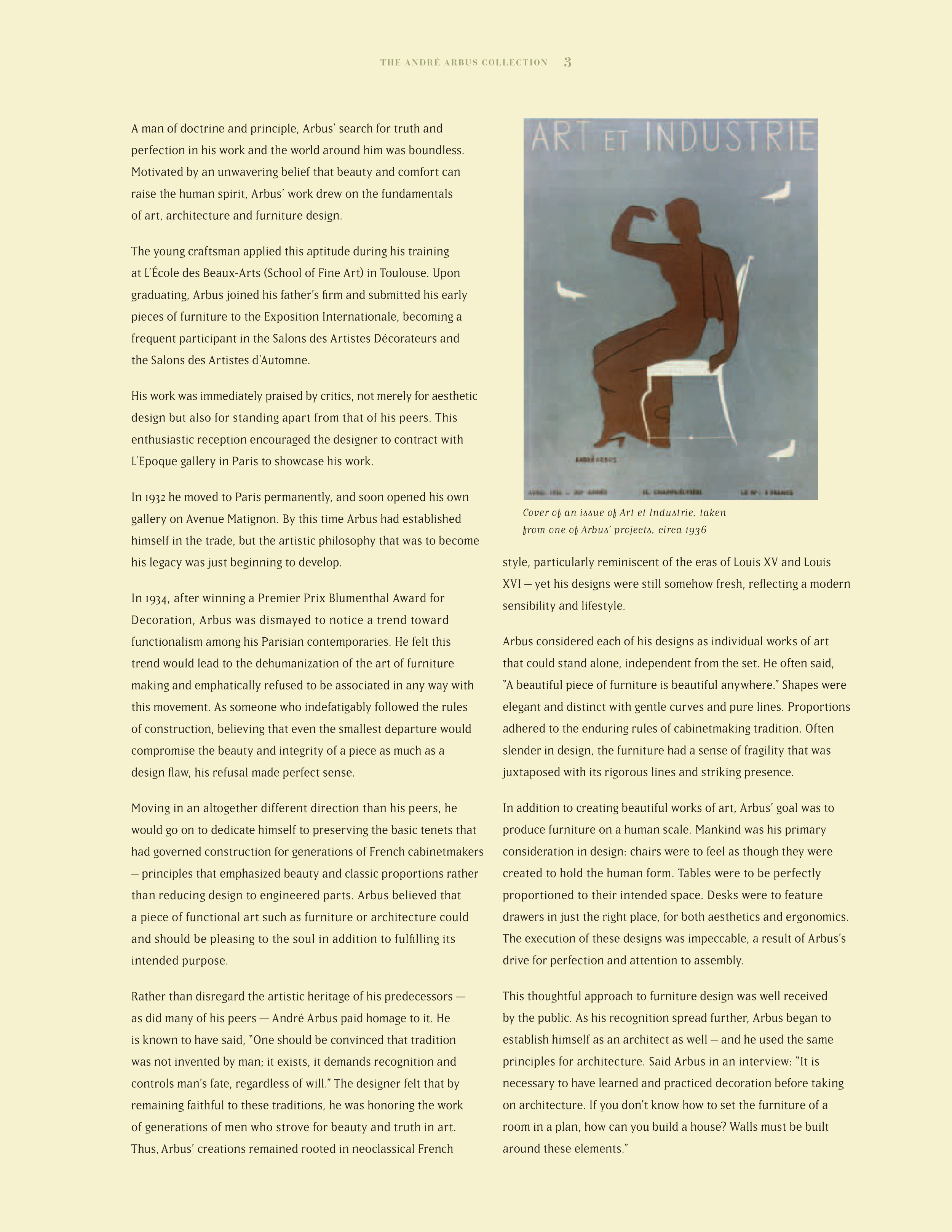A man of doctrine and principle, Arbus’ search for truth and
perfection in his work and the world around him was boundless.
Motivated by an unwavering belief that beauty and comfort can
raise the human spirit, Arbus’ work drew on the fundamentals
of art, architecture and furniture design.
The young craftsman applied this aptitude during his training
at L’École des Beaux-Arts (School of Fine Art) in Toulouse. Upon
graduating, Arbus joined his father’s firm and submitted his early
pieces of furniture to the Exposition Internationale, becoming a
frequent participant in the Salons des Artistes Décorateurs and
the Salons des Artistes d’Automne.
His work was immediately praised by critics, not merely for aesthetic
design but also for standing apart from that of his peers. This
enthusiastic reception encouraged the designer to contract with
L’Epoque gallery in Paris to showcase his work.
In 1932 he moved to Paris permanently, and soon opened his own
gallery on Avenue Matignon. By this time Arbus had established
himself in the trade, but the artistic philosophy that was to become
his legacy was just beginning to develop.
In 1934, after winning a Premier Prix Blumenthal Award for
Decoration, Arbus was dismayed to notice a trend toward
functionalism among his Parisian contemporaries. He felt this
trend would lead to the dehumanization of the art of furniture
making and emphatically refused to be associated in any way with
this movement. As someone who indefatigably followed the rules
of construction, believing that even the smallest departure would
compromise the beauty and integrity of a piece as much as a
design flaw, his refusal made perfect sense.
Moving in an altogether different direction than his peers, he
would go on to dedicate himself to preserving the basic tenets that
had governed construction for generations of French cabinetmakers
– principles that emphasized beauty and classic proportions rather
than reducing design to engineered parts. Arbus believed that
a piece of functional art such as furniture or architecture could
and should be pleasing to the soul in addition to fulfilling its
intended purpose.
Rather than disregard the artistic heritage of his predecessors —
as did many of his peers — André Arbus paid homage to it. He
is known to have said, “One should be convinced that tradition
was not invented by man; it exists, it demands recognition and
controls man’s fate, regardless of will.” The designer felt that by
remaining faithful to these traditions, he was honoring the work
of generations of men who strove for beauty and truth in art.
Thus,Arbus’ creations remained rooted in neoclassical French
style, particularly reminiscent of the eras of Louis XV and Louis
XVI – yet his designs were still somehow fresh, reflecting a modern
sensibility and lifestyle.
Arbus considered each of his designs as individual works of art
that could stand alone, independent from the set. He often said,
“A beautiful piece of furniture is beautiful anywhere.” Shapes were
elegant and distinct with gentle curves and pure lines. Proportions
adhered to the enduring rules of cabinetmaking tradition. Often
slender in design, the furniture had a sense of fragility that was
juxtaposed with its rigorous lines and striking presence.
In addition to creating beautiful works of art, Arbus’ goal was to
produce furniture on a human scale. Mankind was his primary
consideration in design: chairs were to feel as though they were
created to hold the human form. Tables were to be perfectly
proportioned to their intended space. Desks were to feature
drawers in just the right place, for both aesthetics and ergonomics.
The execution of these designs was impeccable, a result of Arbus’s
drive for perfection and attention to assembly.
This thoughtful approach to furniture design was well received
by the public. As his recognition spread further, Arbus began to
establish himself as an architect as well – and he used the same
principles for architecture. Said Arbus in an interview: “It is
necessary to have learned and practiced decoration before taking
on architecture. If you don’t know how to set the furniture of a
room in a plan, how can you build a house? Walls must be built
around these elements.”
The andré arbus collecTion 3


